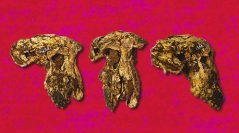

 Geodiversitas
45 (5) - Pages 163-195
Geodiversitas
45 (5) - Pages 163-195Important collections of Plio-Pleistocene cercopithecoid remains has have been discovered in South African karstic sites but few are older than the Late Pliocene. The fossiliferous Palaeokarst System of Bolt’s Farm in the Cradle of Humankind World Heritage Site of UNESCO is known to have yielded a few remarkable remains of cercopithecoids, mainly between 1936 and 1948. The excavation done in Brad Pit B (BPB) which was discovered in 2010, led to the in situ discovery of some fossils in karst-fill breccia correlated faunally to the Middle Pliocene. The cercopithecoids are represented by Parapapio broomi Jones, 1937, and Cercopithecoides cf. williamsi Mollett, 1947. At BPB, we have potentially the oldest known co-occurrence of these two taxa in Southern Africa, the second oldest being at Sterkfontein-Member 2. The currently available evidence suggests dispersal of these two genera from East Africa to Southern Africa, a hypothesis generally accepted by most authors, even though the period of dispersal is now considered to be somewhat earlier than previously thought. Whereas the Early Pliocene environment in the Cradle of Humankind seems to have been drier than that of today, it was probably more humid during the Middle Pliocene which would have allowed the dispersal of these two taxa.
Pliocene, Primates, Parapapio, Cercopithecoides, Cradle of Humankind, Bolt’s Farm